Shutter induced blur with the Pentax K-5 camera
– White Paper –
LumoLabs (fl)
(Falk Lumo, f a l k @ f a l k l u m o . c o m )
|
Version: |
1.0 of Dec 1, 2010 |
|
Status: |
Final |
|
Print version: |
www.falklumo.com/lumolabs/articles/k5shutter/ShutterBlur.pdf |
|
Publication URL: |
|
|
Public comments |
This paper studies the impact of the shutter on image sharpness. The operation of a mechanical shutter is known to have a negative impact on image sharpness for all single lens reflex (SLR) cameras and more generally, for all cameras with a focal plane shutter which include range finder and mirrorless system cameras. This is old wisdom. However, the exact magnitude of the effect and the question if it is significant in day to day usage is not very well understood. This paper studies this effect in detail for the Pentax K-5 digital SLR camera. It is meant as a companion study to the same work carried out for the Pentax K-7 SLR. It is assumed that a reader is familiar with the companion study before proceeding beyond the summary section.
All content in this paper is © 2010 author.
A first reading of LumoLabs' white papers
-
„Shutter induced blur with the Pentax K-7 camera“ [www.falklumo.com/lumolabs/articles/k7shutter/] and
-
„Understanding Image Sharpness“ [www.falklumo.com/lumolabs/articles/sharpness/]
is highly recommended
1. Summary
As every camera, the Pentax K-5 produces shutter blur. At its maximum effect (around a shutter speed of around 1/80s), it increases overall blur which is increased from about 1.5 pixels to 2.3 pixels, a difference of 0.8 px. So, even though the K-5 is a high density APS-C camera with a small pixel pitch of 4.8 µm, the shutter blur remains a subpixel effect which will pass unnoticed in day to day work. This finding is further supported by the fact that so far, no K-5 photographers have raised concerns regarding shutter blur or mirror slap.
Note: the mirror on the K-5 is dampened so well that its slap has no effect on image sharpness I can measure, at least not free hand. With a tripod, mirrors may always excite vibration in a weak tripod.
Outside the region of 1/160 s – 1/40 s (±1 stop around 1/80 s), the effect is half or less and probably inexistant even for scrutinizing pixelpeepers.
With respect to other cameras, the K-5 has somewhat more shutter-induced blur than cameras with a slower shutter. However, I have no reason to believe that other cameras with similiarly fast and robust shutters would measure significantly different from the K-5. The K-5 has about 0.6 pixels shutter blur at 1/160 s which should be the peak value for a classic 1/180X shutter. All similiarly fast and fine pitch cameras may exhibit the same about 0.5 pixels shutter blur. I could not find a work which says otherwise and subpixel blur width effects normally remain unnoticed.
In summary: While the K-5 shutter and SR mechanism can be further improved to make it more immune against shutter-induced blur, the overall performance probably is now on par with cameras featuring a similiarly specified robust and fast shutter (1/8000 s; 100k+ actuations). The absolute visible effect remains smaller than a pixel.
2. Measurements
Note: Don't read beyond this point without first referring to www.falklumo.com/lumolabs/articles/k7shutter/ and www.falklumo.com/lumolabs/articles/sharpness/.
2. 1. Overall blur with a 12 mm ultra wide angle lens
All measurements have been carried out with one Pentax K-5 camera sample and the same Sigma 12-24 lens I already used in the K-7 study. I examined about 660 test shots and 1500 blur widths / MTF curves. Most measurements have been made using my class C tripod setup to emulate a shake-free hand. I verified again that the results using real free hand shooting incl. mirror slap are the same. Measurements use the „sharp setting“ raw workflow and are based on the slanted edge SFR method. Blur widths are as defined by the 10-90% rise edge function width.
The first chart below shows an overview of results. The overall blur is defined as
blur2 = (b2pitch + b2yaw) - b20
and b0 is estimated from the overall chart (verified by class A tripod measurements for the K-5). The above formula corrects for the fact that b0 is already included in each of bpitch and byaw measurements. Note that blur2 = (b2pitch + b2yaw) / 2 would also include b0 only once but yields an incorrect estimate for directional blur.
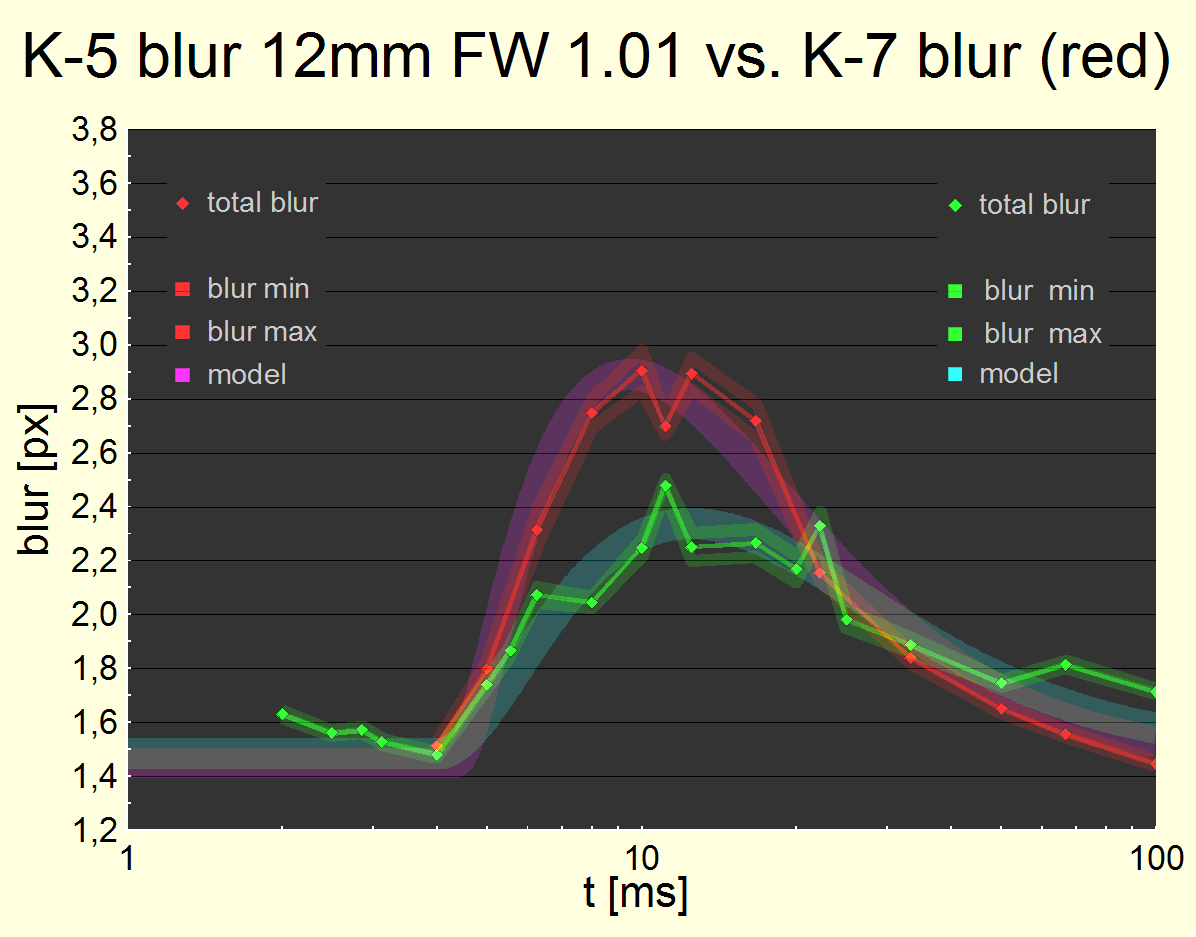
Fig.1 Image blur widths of both the Pentax K-5 (green) and Pentax K-7 (red) cameras.
The data points for the K-7 are a remeasure for the K-7 I did on behalf of Pentax. The results are in line with results as previously published. The K-5 are fresh measurements with v1.01 firmware.
The data points are the mean values of blur width measurements for a given exposure time and camera. The fat lines surrounding a data line in a same color are the upper and lower confidence values for the mean value (error margin), based on standard deviation and sample size, ignoring systematic errors. The increase at very fast shutter speeds is due to increasing ISO noise.
The very fat
line is a model fit using the model ?
(t,t) = 4 t t /
(t +
t)2 as defined in section
„4.4 Extraneous blur parameterization
function“ of the K-7 paper.
The fit parameters for blur = a
? (t-t0,
t-t0) and
using the Kodak formula for p=2 and with
b0 are:
K-7: a =
12.5 µm
t =
1/105 s
t0
= 4.3 ms
b0
= 1.45 px (5.0 µm/px)
K-5: a =
8.7 µm
t =
1/80 s
t0
= 4.0 ms
b0
= 1.48 px (4.81 µm/px)
The blur at t=1/160 s should be dominated by classic (unavoidable) shutter blur caused by the travelling shutter masses which must move the body in the opposite direction. The measured value of about 2.2±0.1 pixels isn't statistically significantly different between the two bodies and may be a sign that both cameras basically share the same shutter. While classic shutter blur would attenuate quickly for slower shutter speeds, reaching about half its value at 1/80 s, the shutter blur for K-5 and K-7 isn't attenuating before 1/80 s is reached. That's a sign that the shutter made something vibrate within the camera body which isn't attenuating as quickly. However, while this vibration almost doubles the shutter blur in the K-7, it doesn't in the K-5 where blur at 1/160 s and 1/80 s is rather similiar. This may be a sign that something in the K-5 shutter was dampened to mitigate the effect. We'll look at this again in the conclusions section.
2. 2. Detailed measurements
For the sake of completeness, I'll publish additional measurement detail here.
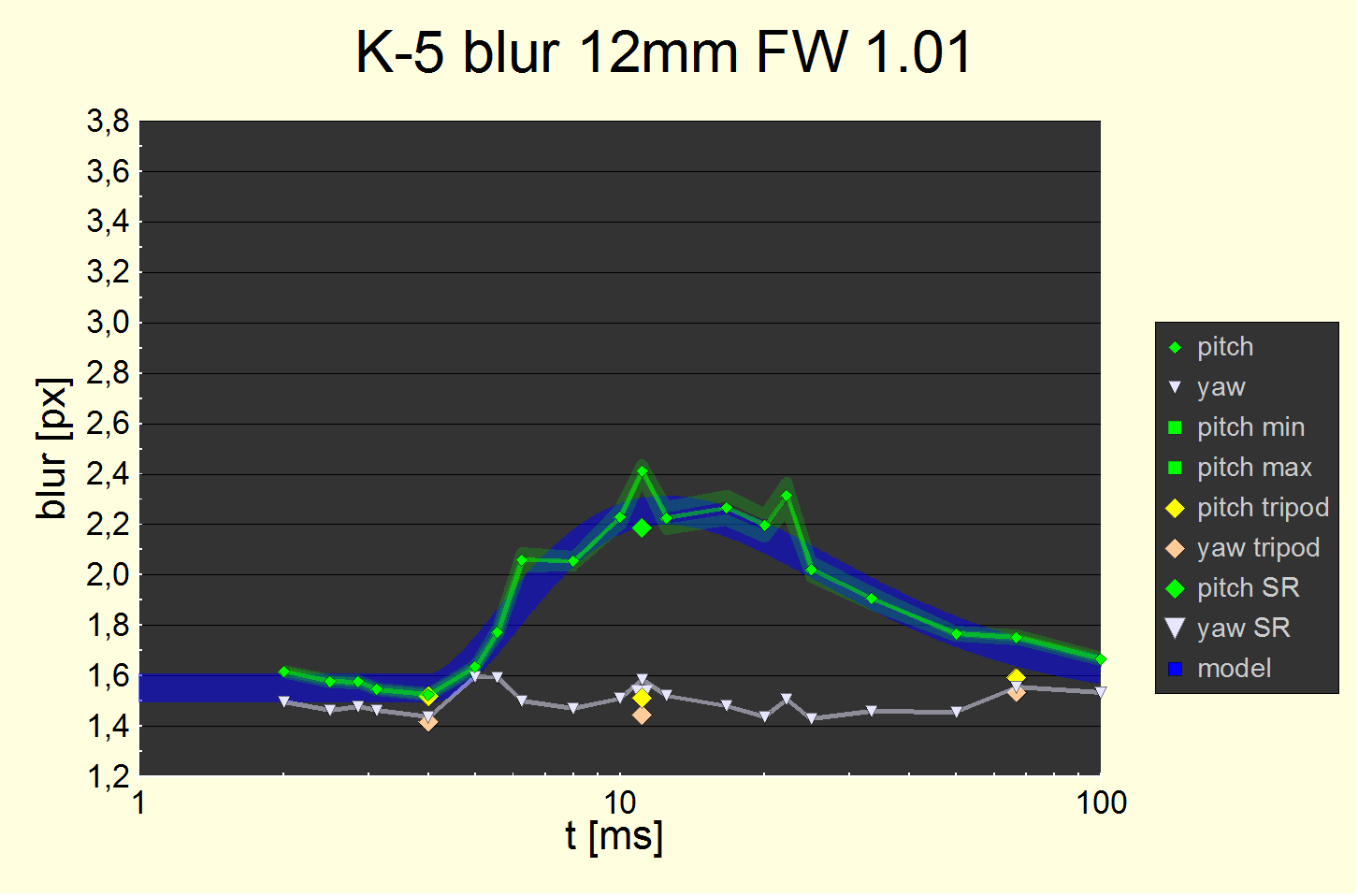
Fig. 2 Separate measurements of pitch blur (green) and yaw blur (gray), incl. error margins.
The isolated green and gray data point are from a true free hand test with SR enabled. All other data points are from a class C tripod test with LV (MLU), remote trigger and SR off. The brown and yellow points are from a class A tripod test (stone table clamp tripod).
The raise below 1/250 s is due to an increase in image noise, below 1/20 s is due to a loss of tonality in the whites (if you consider an increase by 1/20 pixel to be noteworthy ;) )
The model curve is for pitch blur only and has an amplitude of a=7.9 µm. Unlike the corresponding K-7 data, the shutter has no effect on yaw blur at all. Another possible sign for better dampening.
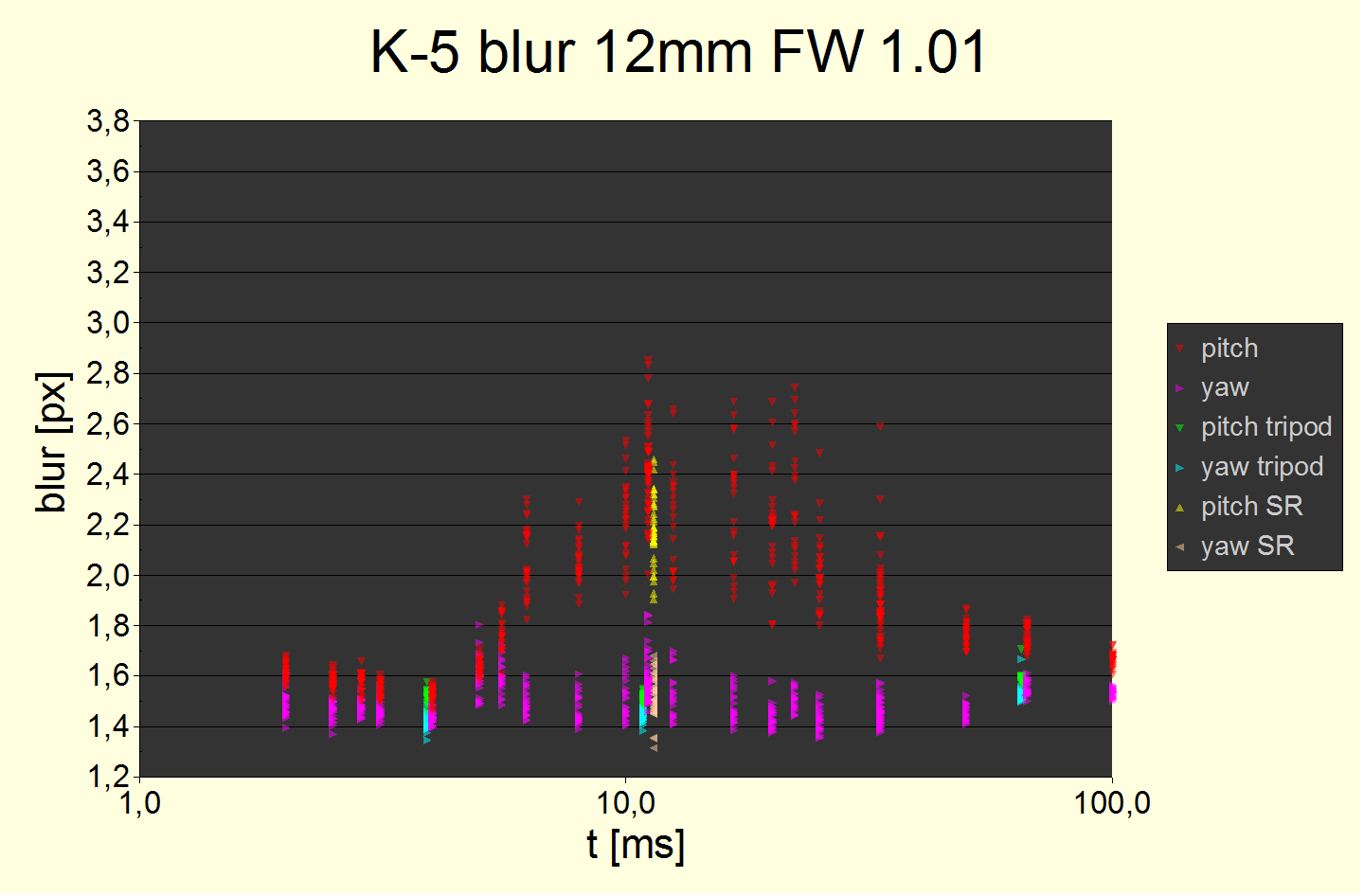
Fig. 3 Individual pitch (red) and yaw (pink) blur measurement data points.
The yellow and brown points are from a free hand measurement which turned out to have a bit better focus. The corresponding chart for the K-7 goes up to 3.8 px in a few extreme cases which explains the scale used in plots. The class A tripod values are in green and blue.
This means that not only mean shutter-induced blur of the K-5 is about half the value in the K-7, the extreme blur values are about halved as well.
Nevertheless, in rare cases shutter-induced blur still can be noticeable. From the almost thousand shots I made, here is the worst one, „complete“ with its edge and line spread functions:
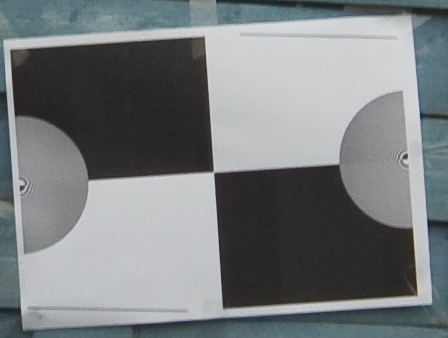
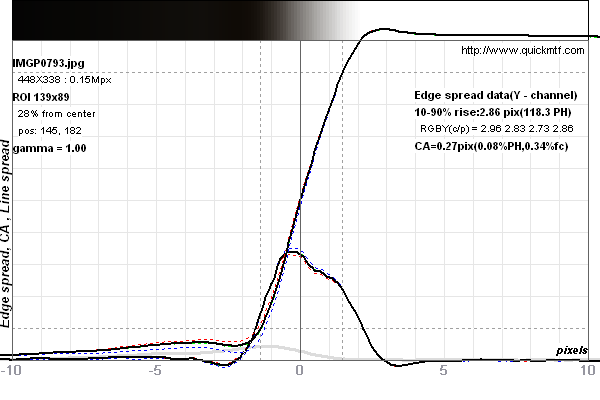
Fig.4 Worst case sample.
This is a case where shutter blur even with a K-5 is noticeable. However, it normally isn't and this is the single worst example from over 500 shots. Shown are both a 100% crop and the ESF/LSF.
It exhibits the characteristic double peak LSF which isn't seen for classic shutter blur.
While the worst case sample shows that the shutter-induced blur can occasionally show up in day to day work, we see too that at all shutter speeds, many samples exhibit less than 0.5 pixels shutter blur. So, if in doubt, press the shutter twice. A good advice probably for any camera. Certainly true if shooting free-hand anyway.
3. Discussion
As has been said, I measure shutter blur from the K-5 which is significantly less that that in a K-7 at around 1/80 s (almost halved) but about the same around 1/160 s and 1/40 s. At around 1/160 s I expect other cameras with fast and solid shutters to have comparable shutter blur. Between 1/160 s and 1/40 s, the blur „response“ to the shutter is rather flat for the K-5 while it peaks in between for the K-7 . That's the main issue for the K-7 and it may be considered to be solved.
Also, part of the improvement is from the non-linear dependency of blur width with image shift. The measured image shift is about 8 µm down from about 12 µm for the K-7 which is two thirds, not halved.
The flat response may be a sign that there is still some vibration going on in the camera body but that things are dampened better. I consider this to be a temporary solution. I expect Pentax to research the core cause of the vibration and to eliminate, rather than dampen, it. In order to improve forthcoming models.
3. 1. Competitive remark
Let's compare the finding to other cameras, i.e., the K-7, the K20D and other vendors. As said, the K-7 has significantly more total shutter blur, about an increase from about 1.45 pixels to 2.9 pixels, a difference of 1.45 px with slightly larger 5.0 µm pixels. Comparing this to 0.8 pixels for the K-5 then this is nearly twice as much visible blur increase. Which was sufficient to make people take notice and ultimately gave us reason to do the corresponding study.
The K20D has almost no measurable shutter blur, about 0.2 pixels only. But blur widths don't add linearly. Part of the K20D shutter blur is masked by the anti-alias (AA) filter. So, one way to put the result is that the K-5 is half way between the K20D and the K-7. All three cameras have a floating sensor shake reduction mechanism.
With respect to other cameras, notably those with lens-shift image stabilization, the corresponding shutter-induced blur values will depend on how immune a lens is against shutter-induced acceleration (for a stabilized lens with a „floating“ lens element) and how fast and heavy its shutter is. As said above, I expect cameras with „classic“ shutter blur (vibration-free) to have about the same amount of blur around 1/160 s. But less at 1/80 s (while the K-5 hasn't less). And in consequence, less at 1/40 s too. However, this may only be of concern if shutter blur at 1/160 s is of concern at all for any camera to start with ...
3. 2. Disclaimer
I only tested a single sample. I may have seen a postive sample variation from the K-5 and a negative from the K-7. Moreover, I received my K-5 camera directly from Pentax in Paris. It may have been preselected.
Do I think this is the case?
No. For the follwowing reasons. First the preselection: I know the person who sent me the camera and he wouldn't have done that. The camera came original from the Brussels warehouse and EXIF showed 1 shutter actuations for the first image I shot. Pentax probably wouldn't even know how to preselect.
Do I see sample variation? Possible but unlikely.
The shutter blur for the K-7 was reported before our study and verified by dozens of independent sources. We tested several K-7 and the issue was similiar.
For the K-5, there are no reports for shutter blur. Something is better this time. And my findings are just in line with that. I may just as well have tested a sub average K-5 unit actually ...
So, if the K-5 has less shutter blur, what was changed? Well, if I'm not mistaken, something must have changed. I am under the impression that both the shutter and SR mechanism are essentially unchanged from the K-7. And Pentax hasn't found the root cause for the shutter-induced blur yet (I think I know this). So, I guess that the improved shutter blur may be from some variation of a production detail, maybe even an arbitrary one.
 One possibility
(and I don't say this is the difference) is
the addition or change of an absorber to the bottom box of the
shutter (where the curtains run into at the end of their run). To
the right is an image of this box I took at Photokina 2010 from a
K-5 cut model. The darker material looks like some absorbing
material to me. I don't know if it is a new element in the shutter.
I don't have a corresponding image for the K-7. But clearly, the
curtains don't run at full speed onto a metal stop for the
K-5.
One possibility
(and I don't say this is the difference) is
the addition or change of an absorber to the bottom box of the
shutter (where the curtains run into at the end of their run). To
the right is an image of this box I took at Photokina 2010 from a
K-5 cut model. The darker material looks like some absorbing
material to me. I don't know if it is a new element in the shutter.
I don't have a corresponding image for the K-7. But clearly, the
curtains don't run at full speed onto a metal stop for the
K-5.Here is a sound recording of only the first curtain opening, first 6 times for the
K-7, then 6 times for the K-5
->
Sound clip.
You may or may not hear a difference, depending on who you ask ;) I believe to hear a somewhat more hollow sound for the K-7.
So, there may be a change in the body. I cannot reliably say though. Moreover, if the shutter was modified, chances are high the modification was applied to current batches of the K-7 production too. There is no reason why K-7 and K-5 shouldn't share the exact same shutter in the fab.
Therefore, people with a newer K-7 may want to retest theirs.
My Serials: K-5: #38304XX; K-7: #34044XX
4. Conclusion
The shutter-induced blur in the Pentax K-5 is measurable but it should be small enough to be of no concern in day to day photography. The absolute magnitude of the effect sits halfway in between a K20D which has almost no measurable effect and a K-7 which exhibits an effect large enough to make some people notice in their work.
The matter may now have reached a satisfactory state with the K-5. But there remains work to be done for Pentax to fully understand and eliminate any unnecessary effects which compromise image sharpness.
It would be interesting to test another camera with fast shutter (like a D300s) to compare the absolute magnitude of the shutter blur effect which is never zero. Esp. at ~1/160 s. Ideally, vendors would measure it and make part of their cameras' shutter specification.
View or post comments: click here